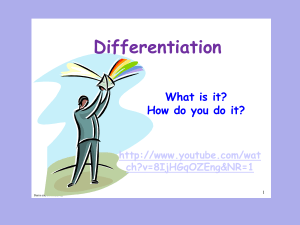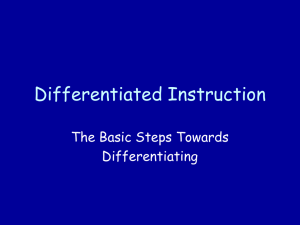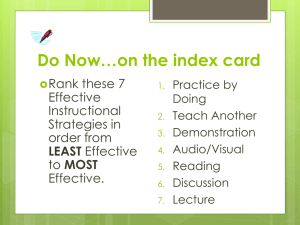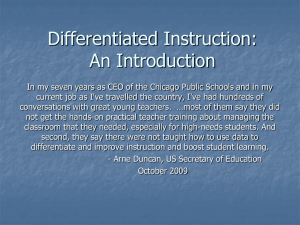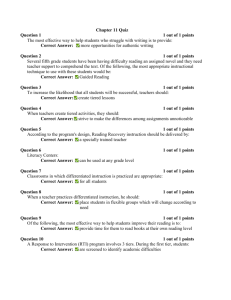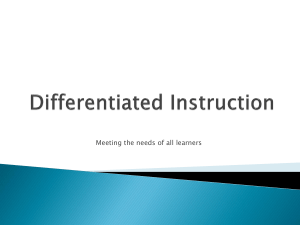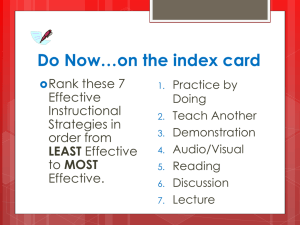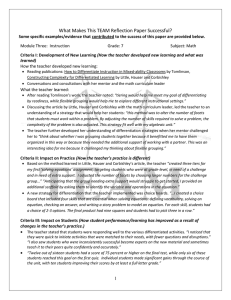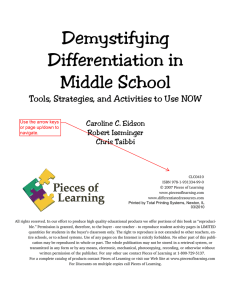Differentiation What is it? How do you do it?
advertisement
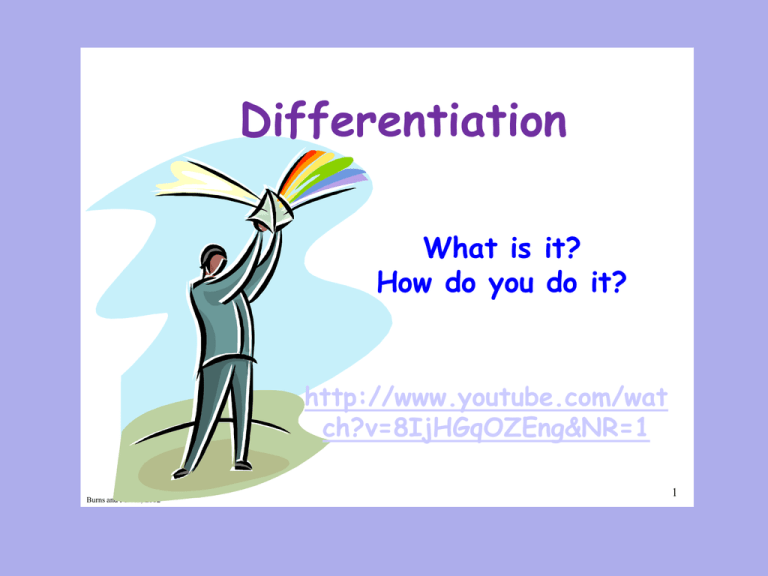
Differentiation What is it? How do you do it? http://www.youtube.com/wat ch?v=8IjHGqOZEng&NR=1 Burns and Purcell, 2002 1 Differentiation is reacting responsively to the learner’s needs to maximize student growth Differentiation is the teacher’s response to the learner’s needs. Differentiation is not a curriculum. It is a way of thinking about teaching and learning. A differentiated classroom will have a combination of teacher directed, teacher selected activities, and learner centered, learner selected activities; whole class instruction, small group instruction, and individual instruction. When Differentiating Instruction, The Three Most Important Questions to Continually Ask Yourself... What do I want my students to know, understand, and be able to do? What will I do instructionally to get my students to learn this? How will my students show what they know? DIFFERENTIATION Curriculum: Content/Process/Product Student: Readiness/Interest/Learning Style Strategy Adapt Content – Process – Product based upon Readiness – Interest – Learning Profile CONTENT is… • What we want students to: - know (facts and information) - understand (principles, generalizations, ideas) - be able to do (skills) Content is differentiated • When you preassess students’ skill and knowledge, then match learners with appropriate activities according to readiness; • When you give students choices about topics to explore in greater depth; • When you provide students with basic and advanced resources that match their current levels of understanding. Differentiating Content - Multiple textbooks and supplementary print materials - Varied videos and computer programs - Learning contracts - Interest centers - Support systems audio tapes study partners and reading buddies mentors - Compacting phase 1 - teacher assessment of student phase 2 - teacher sets up a plan phase 3 - teacher and student design a project Process is . . . How the students make sense of the content. It is the “how” of teaching. Process is The activities that you design to help students think about the key principles and information of the content they are learning. Process calls on students to use key skills that are integral to the unit. Differentiating Process is when students are engaged in different activities. - tiered assignments - learning centers - interactive journals and learning logs - graphic organizers -flexible grouping Each activity should be directed to the lesson’s common focus. Product is . . . The demonstration of the learning. The way students show what they have learned or extend what they have learned. Products can be differentiated along a continuum: - simple to complex - less independent to more independent - clearly defined problems to fuzzy problems Readiness is a student’s entry point relative to a particular understanding or skill. To help a student to grow, we must begin where the child is. Readiness Less ready • May need help More opportunities Structured or concrete activities Deliberate pace learning Readiness More advanced may need Skip practice Complex, open-ended, abstract, and multifaceted activities Brisk pace of work Interest is the child’s affinity, curiosity, or passion. Interest Students attach what they have been learning in class to things that they already find interesting in their own lives. Learning profile has to do with how students learn. Some are visual learners, auditory learners, or kinesthetic learners. Students vary in the amount of time they need to master a skill or learn a concept. How students learn can be shaped by: – environment – social organization – physical circumstances – emotional climate – psychological factors Carol Ann Tomlinson/ Diane Heacox A Closer Look At… • Flexible Grouping • Tiered Assignments Flexible grouping is at the heart of differentiated instruction Flexible grouping: A Definition Flexible small groups are within class grouping in which membership varies according to ability (same ability, mixed ability), interest or questions, learning style or processing style, product style, group longevity, group size (2-10). Groups can be teacher-selected, studentselected, purposeful or random. Flexible Grouping – Individuals – Small groups – Classroom as a whole Flexible Grouping Entire class Same materials Finish together Teacher determined Placed by readiness Teacher help Small groups Multiple materials Need additional time Student choice Random assignment Student help Designing Differentiated Learning Activities for Flexible Groups • Open-ended activities and assignments • Purposefully designed choices to accommodate learning or expression style differences • Purposefully designed tiered assignments Purcell Tiered Assignments are designed to maximize each student's growth by challenging students with learning experiences that are slightly above their current level of knowledge and performance. Tomlinson Designing a Tiered Assignment A six step process • • • • • • Identify the content Consider your students’ needs Create an activity Chart the complexity of the activity Create other versions of the activity Match one version of the task to each student Tomlinson Differentiation In Action http://www.youtube.com/wat ch?v=uU25gNc024I&NR=1 In Summary http://www.youtube.com/wat ch?v=cvsMtWwPwL8*
